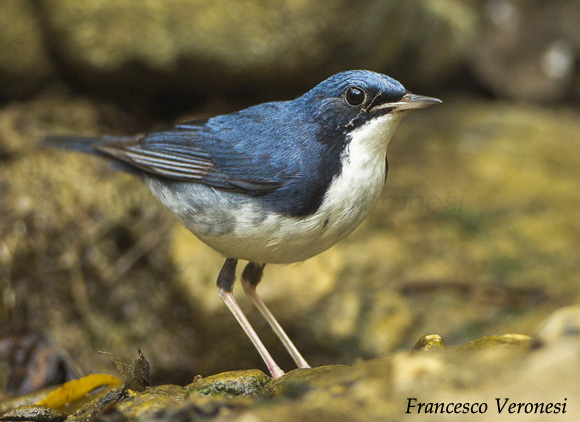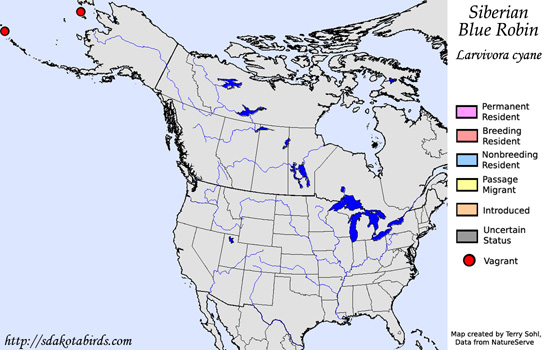| Length: 5.5 inches | Wingspan: 8.5 inches | Seasonality: Non-resident in South Dakota |
| ID Keys: Males deep blue upperparts, white underparts females brownish upperparts. Long legs, strong pale bill | ||
 The
Siberian Blue Robin is a brilliantly colored songbird eastern Asia, found as
a breeding bird in Siberia, northern China, Korea, and Japan. There
are obvious plumage differences between males and females, with males
exhibiting deep blue upperparts and white underparts, while females are
primarily brownish on their upperparts. While similar in appearance and
general structure to several thrush species (and typically classified as a
thrush), there are indications it may be more properly classified as an Old
World flycatcher, or perhaps may belong in a new genus. In North America
they are extremely rare vagrants, with the first two sightings occurring on
Attu Island and St. Lawrence Island in the Bering Sea, off the coast of
Alaska.
The
Siberian Blue Robin is a brilliantly colored songbird eastern Asia, found as
a breeding bird in Siberia, northern China, Korea, and Japan. There
are obvious plumage differences between males and females, with males
exhibiting deep blue upperparts and white underparts, while females are
primarily brownish on their upperparts. While similar in appearance and
general structure to several thrush species (and typically classified as a
thrush), there are indications it may be more properly classified as an Old
World flycatcher, or perhaps may belong in a new genus. In North America
they are extremely rare vagrants, with the first two sightings occurring on
Attu Island and St. Lawrence Island in the Bering Sea, off the coast of
Alaska.
Habitat: Found as a breeder in taiga, including spruce woods and bogs, typically in areas with dense low vegetation.
Diet: Feeds heavily on insects and spiders, particularly during the summer months. They will also feed on berries, seeds and grains.
Behavior: Found at or near the ground most of the time, Siberian Blue Robins often stick to thick cover and can be difficult to observe. As it skulks through the undergrowh, it will often flick its tail.
Nesting: The nest of a Siberian Blue Robin is a bowl shaped depression, placed at the base of a tree or in a similarly protected area. Leaves, grasses, and mosses are used for nest construction, lining the depression and largely enclosing the nest location, leaving a single opening. The female lays between 2 and 5 eggs, which hatch after about 12 days. Both the male and female help to feed and raise the young.
Song: The song of a Siberian Blue Robin is a clear, loud trilling.
Migration: Strongly migratory. The breeding range extends across Siberia and northern China into Korea and Japan. During the winter months they move to southeastern Asia.
Interactive eBird map: Click here to access an interactive eBird map of Siberian Blue Robin sightings
Similar Species: Males are distinctive if seen well. The females may be confused with some of the Old World thrushes such as Rufous-tailed Robin.
Conservation Status: Overall populations appear to be in decline. However they are still found over a relatively broad geographic area and numbers are strong overall. The IUCN lists the Siberian Blue Robin as a species of "Least Concern".
Further Information: 1) BirdLife International - Siberian Blue Robin
2) BirdFellow - Siberian Blue Robin
3) Wikipedia - Siberian Blue Robin
Photo Information: Photo taken by Francesco Veronesi - Licensed under Creative Commons Attribution ShareAlike 2.0 Generic License
| Click below for a higher-resolution map |
 |
| South Dakota Status: Non-resident in South Dakota |
Additional Siberian Blue Robin Photos (coming soon!!)
